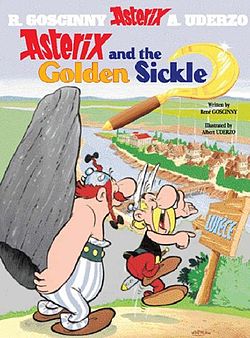- Asterix and the Golden Sickle
-
Asterix and the Golden Sickle
(La serpe d'or)
Cover of the English editionPublisher Dargaud Date 1962 Main character(s) Asterix and Obelix Series Asterix Creative team Writer(s) René Goscinny Artist(s) Albert Uderzo Original publication Published in Pilote Issue(s) 42-74 Date(s) of publication 11 August 1960 - 1961 Language French ISBN Translation Publisher Brockhampton Press Date 1975 Translator(s) Anthea Bell and Derek Hockridge Chronology Preceded by Asterix the Gaul Followed by Asterix and the Goths Asterix and the Golden Sickle is the second volume of the Asterix comic book series, by René Goscinny (stories) and Albert Uderzo (illustrations). It was first serialized in Pilote issues 42-74 in 1960.
Contents
Plot summary
Disaster strikes in the Gaulish village when Getafix the druid breaks his golden sickle. Without one he cannot attend the annual conference of druids, or cut mistletoe for the magic potion which keeps the Roman armies at bay. Asterix and his friend Obelix set out for Lutetia (present-day Paris) to buy a new one from Obelix's cousin, the skilled sicklesmith Metallurgix. On the way they enocunter bandits, but easily defeat them. A man in an Inn they stay at says sickles are in short supply in Lutetia. They finally get to the city.
However, Metallurgix has mysteriously gone missing, and before long our heroes are exploring the underworld of the big city. They go to an Inn opposite, but when they ask about Metallurgix the man close up, and after they are gone gives a description of them to another man. This man finds them, and introduces himself as Clovogarlix, claiming to be a friend of Metallurgix. He takes them to a place where they meet a man called Navishtrix who tries to sell them a sickle for a vast price, though they refuse and wreck the place. They are arrested, but released by the Prefect, and find out from a Centurion that Metallurgix may have been kidnapped. They uncover a sickle-trafficking gang with sponsors high up the Roman bureaucracy, whose shadowy business is run from below a portal dolmen in the Boulogne forest. The two enter the forest and get directions from a bandit they save from wolves. They get into the lair and find a horde of Golden Sickles, but are attacked by a gang that includes Clovogarlix and Navishtrix, but they defeat them. Navishtrix gets away, but they find him with the local Roman Prefect, revealed to be the leader. When all is revealed and the Gauls have rescued Metallurgix, and the Prefect has been arrested for sickle-trafficking, while the sickles beneath the Dolmen have been returned to Metallurgix, they can go home with a new sickle for the druid which Metallurgix gives them for free and the magic potions will continue to flow.
Notes
This is the first time Obelix has a major role in the story and highlights his keenness to fight at every opportunity. It is also the first journey away from the village for Asterix and Obelix. There was a planned film adaptation of this book, but it was never released.
- When Asterix & Obelix were eating at an inn, a stranger tells them that Lutetia is a very beautiful but dangerous city and it is probably talking about what Paris is today.
- This is said to be the first story where in the end during the banquet Cacofonix is tied up away from the banquet.
- This is the first time Asterix and Obelix have a mystery to solve also the first and one of the rare times Asterix uses his sword.
- Obelix demonstrates his ability of opening doors with his finger.
Trivia
- The prefect (and chief villain) is a caricature of the actor Charles Laughton.
- Due to a mistake by Uderzo, the final pages were drawn in comic strip panels, which resulted in a printing error (the panels are smaller and the margins are larger than normal) in all versions.
- Lutetia (future Paris) satirizes the big city, in contrast with the countryside (Asterix's village)
- "The great ox-cart race, the Suindinum 24 hours" is a reference to the 24 Hours of Le Mans, France. Suindinum is the old name of Le Mans.
In other languages
- Arabic: أستريكس والمنجل الذهبي
- Bengali: Asterix o Sonaar Kaaste
- Bulgarian: Златният сърп
- Catalan: La falç d'or
- Croatian: Asteriks i Zlatni srp
- Czech: Asterix a Zlatý srp
- Danish: Asterix og trylledrikken
- Dutch: Asterix en het gouden snoeimes
- Estonian: Asterix ja Kuldsirp
- Finnish: Kultainen sirppi
- West Frisian: De gouden sichte
- German: Die goldene Sichel
- Greek: Το χρυσό δρεπάνι
- Hungarian: Az aranysarló
- Indonesian: Asterix dan Sabit Emas
- Italian: Asterix e il falcetto d'oro
- Latvian: Asteriks un zelta sirpis
- Norwegian: Asterix og styrkedråpene
- Polish: Złoty sierp
- Portuguese: Asterix e a Foice de Ouro
- Romanian: Asterix si Cosorul de Aur
- Serbian: Астерикс и златни срп
- Spanish: La hoz de oro
- Swedish: Asterix och guldskäran
- Turkish: Asteriks Altın orak
References
- The complete guide to Asterix by Peter Kessler ISBN 0-340-65346-9
Categories:- Asterix books
- Works originally published in Pilote
- Paris in fiction
- Literature first published in serial form
- 1960 works
- Works by René Goscinny
- Comics by Albert Uderzo
Wikimedia Foundation. 2010.
